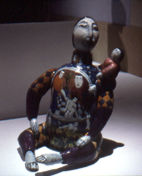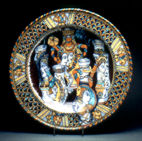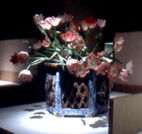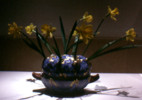



The George R. Gardiner Museum of Ceramic Art

Seduced by Color: The New Maiolica

Walter Ostrom

Deborah Kate Groover

Alexandra Copeland

Bruce Cochrane
MAIOLICA: A SYMPOSIUM
Karen Koblitz
The George R. Gardiner Museum of Ceramic Art (111 Queen’s Park, Toronto, Ontario, Canada; Telephone: 416-586-8080; Web: http://www.gardinermuseum.on.ca) was the first museum in North America devoted solely to collecting and exhibiting ceramics. Their collection includes New World pottery from the Precolumbian period, European pottery and porcelain from the 15th to 19th centuries and Asian ceramics, including a collection of Chinese blue and white porcelain. In 1998, the museum began collecting contemporary ceramics. The Gardiner Museum presents numerous temporary exhibitions each year to enhance the understanding of the permanent collections and to explore a wide diversity of ceramic traditions, both historic and contemporary.
The exhibition “Seduced by Colour: The New Maiolica,” includes twenty six maiolica artists from around the world. Curator, Matthias Ostermann, highlights the uniqueness and diversity of contemporary maiolica production. The Gardiner is a most appropriate venue to showcase this technique given that the Museum boasts one of the finest collections of historical tin-glaze pieces, from the Italian Renaissance and 17th century English delftware, in North America.
Ostermann writes: “When viewing this exhibition, the diversity of expression on display can be seen as part of a long-standing and on-going process of assimilation and transformation of crosscutural influences.” “Figurative, narrative, abstract, functional and sculptural works display the great variety of making and surface treatment techniques inherent in historical and contemporary tin glaze”. Matthias Ostermann is a practicing ceramicist who lives and works in Montreal, Quebec, Canada.
A fresh layer of snow had just dusted the ground in Toronto where two hundred and twenty five clay enthusiasts gathered to attend the exhibition “Seduced by Color: The New Maiolica” and the related symposium “Historical and Contemporary Maiolica.” The Gardiner Museum of Ceramic Art, in conjunction with FUSION: The Ontario Clay & Glass Association and the Istituto Italiano di Cultura, sponsored this one day symposium. This was a truly unique event in which two revered historians shared their ideas with some of the most important contemporary makers of maiolica. It was a marvelous day of lectures in which an intimacy and kinship between the circles of scholarship and creativity were connected and shared.
Many of the speakers had never met except by words and photographs. Their mutual respect and influence were quite apparent. It was marvelous to behold the use of the same image, a plate, a winged vase, that had spawned a career in pioneering contemporary maiolica and luster ware. It was also an historical journey into uncovering methods as well as documenting the original engravings that inspired the great maiolica works of the 16th century Renaissance.
Keynote speaker Timothy Wilson, Keeper of Western Art at the Ashmolean Museum in Oxford, England, started the upbeat rhythm of the day’s presentations in his lecture on Majolica Mania. He was quick to point out that, during the Renaissance, the Medici family paid far more for clothing, jewels and pottery than to any painter or sculptor of the time. In Victorian England during the mid-nineteenth century, great collections of Italian Renaissance Art were amassed with collectors paying far more for objects of the applied arts than paintings. He noted the purchase in 1861 of Piero Della Francesca’s late 15th Century painting entitled, “Baptism of Christ” by the National Gallery for �242. In 1864 the Andrew Foundation paid �450 for the early 16th Century lustered plate adorned with “Three Graces”, painted by the workshop of Master Giorgio of Gubbio. A few years later this same piece sold for �700. According to Wilson, the Victorians paid colossal prices for pottery as they assembled great collections of art in which maiolica played a central role. Today the viewing public can see these extraordinary works in places such as the British Museum, the Victoria & Albert and Ashmolean Museums.
Catherine Hess, Associate Curator at the J. Paul Getty Museum, Los Angeles and author of Italian Maiolica and the newly released Maiolica in the Making: Gentili/Barnabei Archive, introduced the audience to documents of the Carmine Gentili family’s 17th Century Pottery. These papers are the oldest preserved collection of a working pottery which includes many examples of the original cartoons, pounced papers from which designs were transferred onto the tin glazed ware. Through painstaking perseverance and patience she was able to locate plates and other ceramic objects which bear the images of these pounced papers and to locate the original source; paintings, sculptures and engravings of the designs.
Catherine also spoke of erotica in Renaissance Art, an area mostly unexplored by historians. She shared visuals of a series of engravings and plates they inspired showing couples in various Kama Sutra positions. These plates were created to be titillating as well as enjoyed by their owners. She explored the use of sex symbols, used for good luck in the Middle Ages, such as winged penises and women with uplifted skirts that find themselves on apothecary jars. She ended her talk with an image of a plate in which a male head, in the style of Arcimboldo, is entirely composed of penises. Hess believes the original drawing, which the maker of the plate copies, is one that has been attributed to Leonardo Da Vinci.
The ceramicists who were present are all leaders in the field of contemporary maiolica. Walter Ostrom, artist and educator from Nova Scotia, added much humor to the day with his tongue in cheek interpretation of the symbolism one finds on 16th Century Italian maiolica. He showed slides of various betrothal platters that alluded to the high position of the potter. An example is the famous plate from the Victoria and Albert Museum (Cafaggiolo 1510) in which the seated maiolica artist, plate in hand, is painting the portraits of a seated couple. He noted the central position of the painter in elegant clothing and also pointed out that the potter has the best looking legs. After a few other samples of matrimonial plates, he showed us a slide of a platter in which Judith is holding the severed head of Holofernes and announced this as an example of a divorce plate. He then ran through images of many talented artists today who work in maiolica, paying particular homage to Alan Caiger-Smith and to Andrea Gill, the teacher who introduced him to maiolica
Andrea Gill, New York College of Ceramics at Alfred University, completed the morning program in a very personal journey of her maiolica work. Three pitchers from Orvieto, a frontally painted Picasso pot, and a winged Hispano-Moresque vase, are among the pieces that inspired her to work in maiolica. One easily sees why Ostrom attributed her importance to the resurgence of maiolica ceramics in North America. Her extraordinary winged vessels and oval bowls come alive with figurative images, color and design as she proves to be one of today’s most adept ceramicists of visual decoration and pattern.
Two international artists of maiolica, Alexandra Copeland and Eduardo Nery were introduced to the audience. Working on different continents, exhibiting ties to their own cultural identities and expressions in their clay work, each presented their personal ouvre. Copeland, from Melbourne, Australia, creates marvelous decorated large bowls and platters with a strong sense of design and color culminating in a very rich surface. Her work is lyrical with strong linear drawings. These are influenced by things such as fabric design which is familiar to her through frequent travels to Afghanistan as a textile dealer and to simple flowers she observes in her garden. She and her husband sold their home to finance a trip around the world to do research for her recently published book, “An Artist’s Travel Guide to the Ceramics Museums of Europe.” On this journey, Copeland was invited to stay at Dartington Potteries in England where she worked for two months before discovering that the chair in which she sat every day was the chair of its founder, Bernard Leach.
Mixed media artist Eduardo Nery, from Lisbon, Portugal, presented slides of his applications of tile in architecture. On a large wall in a bank he wove small fragmented squares of figurative 17th and 18th Century Portuguese blue on white maiolica tile with rows of various values of solid blue tile. He also demonstrated himself to be quite inventive in using a highly lustered multifaceted tile surface on the exterior of a building to illustrate how the reflection of light changes according to the time of the day. One can also see his work in a Lisbon subway station where his use of white tile covers the entire walls on which images appear in traditional cobalt blue of life size figures in Victorian dress. The figures are playfully reconfigured with an all white tile inserted in a checker boarded pattern within the illustrations and with certain elements placed askew. In another project, his elegant illustrations show the architecture of the Renaissance as it turns into a space ship. He concluded his presentation with the installation, 2 meters high and 100 meters in length, that graces the top of the wall at the Macao International Airport. This is a rich brocade of woven color and design, that includes images of the culture such as large sailing ships. He told me later that this was a very difficult project since the community was very particular about the images he selected and his color palette.
Alan Caiger-Smith, a man who everyone paid tribute to in their talks closed the day’s program. He began by thanking everyone for the accolades he received throughout the day and was quite modest about his importance in the field of maiolica. He shared with us his personal passage into tin glaze with many humorous anecdotes. In a quest for the perfect red glaze he was introduced to the world of Hispano-Moresque Lusterware. Caiger-Smith talked about the moment he discovered this ware and likened it to entering a game parlor with the flashing lights and whistles that go off when one has “hit the jackpot.”
He shared with the audience a letter he received early in his career from, Bernard Leach, his grandfather’s cousin. Leach congratulated him on his acceptance into an exhibition and on his work which embraced a very different path than Leach’s. Also, we were treated to slides which were taken on trips to Tunisia and Egypt. It was most enjoyable to listen to and observe Caiger-Smith’s journey. He traveled the world to research the historical context of maiolica and lusterware and, in his studio in England, paved his own path of personal expression in his revered lustered works. Caiger-Smith is known to all within the community of ceramics as an author of books in which he shares his knowledge as historian, maker and teacher of the secrets of maiolica. He spoke of all the work that has preceded us and all the exciting work still to be done. He brought a number of small lustered works from England, each piece beautifully decorated with strokes of red and gold luster, that were on view at the Gardiner Museum and quickly purchased by collectors.
Canadian maiolica artist Matthias Ostermann, guest curator of the exhibition and symposium organizer , along with Sue Jefferies, Assistant Curator of Contemporary Ceramics at the Gardiner Museum, have to be commended for their successful vision in the planning and implementing of the program.Matthias talked about this event being a true a labor of love in which he assembled all of his favorite people that have been so important to him in the world of maiolica. The result was truly inspirational.
One can read more about maiolica ceramics in Ostermann’s newly released publication, The New Maiolica: Contemporary Approaches to Colour and Technique.
Karen Koblitz is a ceramicist from Los Angeles, California where she teaches ceramics at the University of Southern California. She has a Bachelor of Fine Arts degree from California College of Arts & Crafts and a Master of Fine Arts degree from the University of Wisconsin-Madison. Her work is in the collection of the Los Angeles County Museum of Art; the Boise Art Museum, Idaho; the Charles A. Wustum Museum, Racine, Wisconsin; and The Contemporary Museum, Honolulu Hawaii. She has created numerous Public Art commissions and for the past ten years has been a guest artist and designer of works, in maiolica, at the Grazia Factory in Deruta, Italy.
Andrea Gill

Sigrid Hilpert-Artes

Angelo di Petta

Eduardo Nery

Karin Pavey

Liz Quackenbush